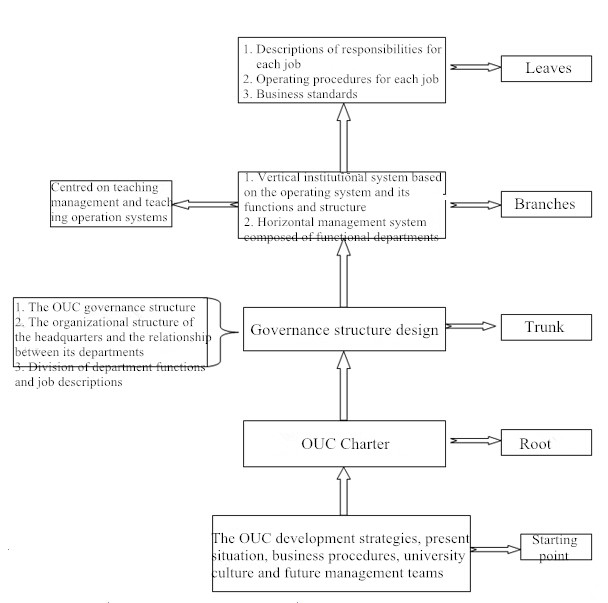Page 4 of 5
2. Framework for the construction of the OUC institutional systemTaking the foundation, historic responsibility, functional orientation and development strategy of the OUC as the starting point, figure 4 visualizes the construction of the OUC institutional system as a tree; it makes the OUC Charter its root, the OUC governance structure and system mechanism its trunk, teaching management and teaching operation system its branches, and business standards, operating procedures, and job descriptions its leaves.

Figure 4 The Construction of the OUC Institutional System in Tree Form
2.1 The OUC Charter clarifies the core and fundamental content of the construction of the OUC institutional system
The OUC Charter forms the core of the OUC modern university system. It is the fundamental guiding document for the OUC education and teaching activities, and is the bedrock for formulating all rules and management measures. It is the OUC’s “fundamental law” that binds the entire operating system. The basis for the formulation of the OUC Charter is the Higher Education Law, Interim Measures for Formulating Higher Education Institution Charters issued by the MOE, and the Strategic Plan for the Open University of China, approved by the MOE. Elements of international open university charters have also been used for reference. It is necessary to explore a “modern university spirit”, in order to stimulate system reform and innovation both in theory and in practice, based on the realities of the RTVU system. A people-centeric core concept must be upheld in order to demonstrate the OUC’s philosophy value, concept and characteristics, development goals, and strategies. Furthermore, it must regulate the various kinds of relationships within the OUC; clarify the leadership system, governance structure and management methods; stipulate the rights and obligations of the faculty members and the students; and show off the OUC system with Chinese characteristics to the international audience.
2.2 The innovation of the governance structure constitutes the basic content of the construction of the OUC institutional system
The design and innovation of the governance structure form the backbone of the construction of a modern university system. This includes research and design to ensure its construction and to regulate its operating mechanism, as well as systems and mechanisms for independent university management, self-development and democratic social management. In terms of organizational structure, the OUC headquarters are built on CCRTVU, setting up consultative committee, council, administrative affairs committee, advisory committee, academic committee and quality guarantee committee and the relevant function departments, establish leadership system with the “council” at the core, and absorb the OUC headquarters, branches, local colleges, and learning centres, as well as representatives from the MOE, educational departments of each province (or autonomous region or municipality), cooperative education units, teachers, students, graduates, specialists and scholars in participation of the OUC management and decision-making. Democratic decision-making helps to improve work methods, strengthen the implication of the OUC construction, increase efficiency, and constantly upgrade the overall coordination and service capabilities of the entire OUC system.
2.3 Teaching management and teaching operation systems make up the centre of the construction of the OUC institutional system
The vertical institutional system based on the operating system and functional structure, and the horizontal management system of functional departments are both branches of the OUC modern university system framework, whose core aim is the construction of a teaching management and teaching operation system. In the early stages of the OUC construction, improvements were made to the RTVU system’s teaching and management, exploring the establishment of management and operating mechanisms for the OUC system that are appropriate to new methods of teaching management and new types of management institutional system under the guiding principle of “stable transmission, proper connections and coordinated operation”. The establishment of the teaching management system ensures that registration, course selection and examinations can be completed at any time. The reform of the mechanism for the construction of majors and courses establishes a platform for sharing and mutual construction. The formulation of quality standards improves the learner-formation and creates a quality assurance system to monitor the quality of education and teaching. The headquarters, branches, local colleges and learning centres all perform their own functions and take responsibility for ensuring the effective implementation of all the stages of the education and teaching quality assurance system in order to complete the process of learner-formation with high quality. Emphasis is placed on the implications of teaching, maintaining a balanced relationship between scale and quality, and the proper settlement of conflicts between open learning and quality control. In addition, measures are taken to ensure that manpower, financial resources and material resources are concentrated on education and the constant improvement of teaching quality.
2.4 Rules and regulations on business standards, departmental responsibilities, and operating procedures form the leaves and terminal point of the construction of the OUC institutional system
The systems in this part are mainly based on the above three levels and refer to more detailed operational and procedural documents after the completion of the design of the OUC organizational structure, including job specifications, management manuals, procedures, work manuals, and management records relating to teaching, management, quality, evaluation, resource sharing, learner support and credit bank. Standardized work criteria are established by elaborating, quantifying, standardizing, streamlining and coordinating the links between all areas and departments of the management, whose aim is to scientifically define division and coordination, and duty and responsibility; establish a coordination mechanism for the overall operation of the OUC; and formulate a unified, scientific, systematic and refined management model.